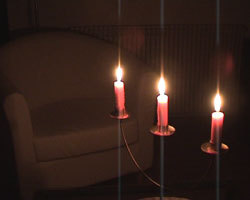Comparison of Four 800,000-Pixel Camcorders
Sensitivity
Mass market models, which don't have sensors big enough to capture the light, usually don't offer great sensitivity. A year ago, sensors were 1/4 of an inch, but this year the race for compactness has reduced them to 1/6 of an inch. This has had affected sensitivity. Fortunately, some makers (like Sony) have worked out solutions to limit the negative impact of this development. The DCR-TRV22 has a Super HAD (Hold Accumulated Diode) 1/4" sensor. This technology substantially increases the photosensitive surface by using micro-lenses, which optimize photon capture. The result is that, while the subject may not be highly visible, the image suffers from hardly any noise.
Sony DCR-TRV22
Take no notice of the claims the manufacturers make in their technical data; the sensitivity thresholds they give are frequently exaggerated and allow for the slow shutter speed or infrared system integrated to increase brightness levels artificially (at the cost of a jerky, monochrome image).
The accepted minimum lighting for a clear image is 100 lux, but the thresholds the manufacturers actually deliver are all less than 10 lux.
Sensitivity may or may not be an issue for you because each user has his or her own idea of quality. Some prefer the esthetic side and want an image without any noise. Others find the content more important, even if it comes with grain. Our tests show that the Sony DCR-TRV22 stands out from the others with a virtually noise-free image.
The NightShot mode on the Sony DCR-TRV22 activates an infrared lamp, which increases brightness artificially.
Get Tom's Hardware's best news and in-depth reviews, straight to your inbox.
